2017
Revitalizing North Dakota Communities with Trees
Governor Doug Burgum has kicked off a series of meetings to discuss the newly evolving North Dakota Main Street Initiative with community leaders and residents. At the heart of this statewide initiative is an effort to identify the unique attributes of North Dakota communities. With more than 300 incorporated municipalities in the state, it is up to each area to identify their strengths and build upon them. While one town may have a strong agricultural sector, others have access to natural amenities or a vibrant cultural arts community. Key to every successful community is the ability to recruit and retain workers and improve quality of life; we want safe, healthy cities with vibrant, walkable main streets and downtowns.
At the risk of oversimplifying the daunting task of creating safe, healthy cities, consider how areas with trees contribute to this very thing:
- Trees filter airborne pollutants and reduce the conditions that cause asthma and other respiratory problems.
- Neighborhood parks promote exercise, especially to people living within a mile of a park. In one study, 75% of park users lived a mile or less from the park. In most North Dakota communities with a city park, that park is surely within one mile of resident homes.
- A study on children with attention deficit disorders discovered that the effect of a walk through a park is equal to peak effects of two typical ADHD medications.
- Visual exposure to settings with trees helps recovery from stress within five minutes, as indicated by changes in blood pressure and muscle tension.
- Green environment impacts worker productivity: in one study, workers without nature views from their desks claimed 23% more sick days than workers with views of nature.
- Trees improve driving safety. The presence of trees in a suburban landscape significantly reduced the cruising speed of drivers by an average of 3 miles per hour.
In addition, trees can help save money and even “make” money for your community:
- Street trees prolong the life of pavement. Shaded roads can save up to 60% over 30 years of repaving costs by reducing pavement fatigue, cracking, rutting and other distress.
- Just three strategically placed trees around buildings can decrease utility bills by 50%. Shading an air conditioning unit can increase its efficiency by 10 percent.
- Urban trees can reduce annual storm water runoff by 2-7 percent, and a mature tree can take up and store 50 to 100 gallons of water during large storms.
- Shoppers will travel further and longer to visit a district with high quality trees, and spend more time there once they arrive. Consumers will spend 9 to 12 percent more for products in business districts with attractive tree-lined spaces.
Communities across North Dakota have collaborated with the ND Forest Service to complete hundreds of planting and program development projects along streets, in schoolyards and in parks. How can your hometown become a more vibrant community?
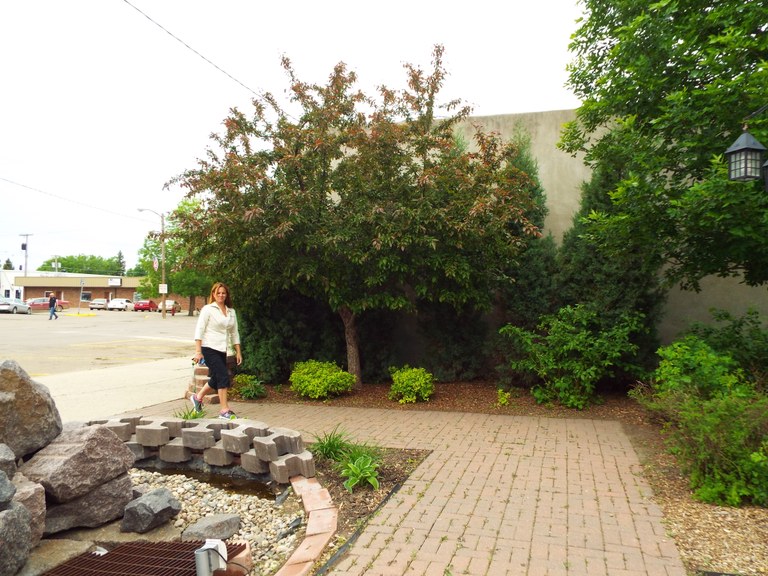
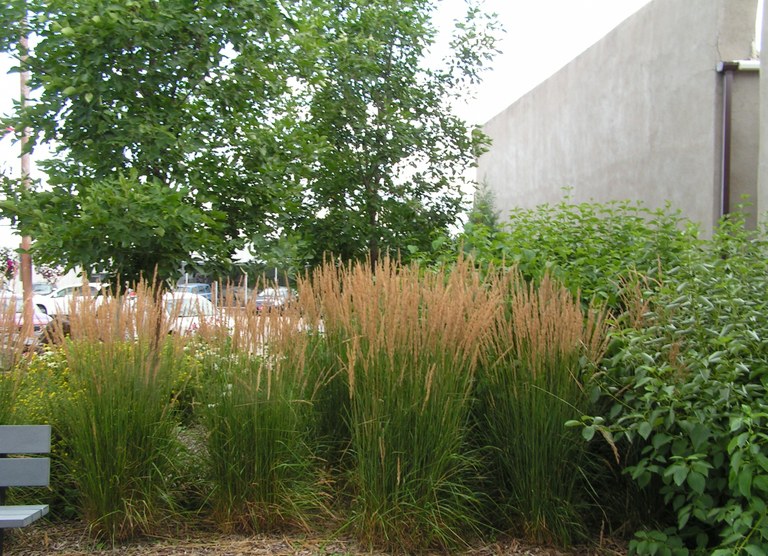

Photos: Hazen’s downtown “pocket park” includes wooden shelters, a water feature, colorful flowers and an assortment of trees and shrubs. It is a favorite spot for many community and family gatherings.
See: “Benefits of Trees and Urban Forests: A Research List,” Alliance for Community Trees, August 2011. Web: www.ACTrees.org
Gerri Makay
gerri.makay@ndsu.edu
ND Forest Service
Cost of Gain for Backgrounding Calves
Figuring out the cost of gain on feeding calves depends on several variables - cost of feed, yardage, interest, veterinary costs and other inputs. Feed cost is the largest of these expenses and can range from $0.30 to $0.45 or higher per pound of gain. Overall cost of gain might be $0.50 to $0.80 per pound.
Jory Hansen, Farm Business Management Instructor at the CREC, has a chart that looks at breakeven analysis with $0.30 - $0.55 feed cost of gain for 550 pound calves fed at different rates of gain and purchase prices at a constant 120 days on feed. As rate of gain increases and more pounds of weight are sold, the cost of gain decreases. For more information on this chart please contact Jory at 701-652-2951.
An easy-to-use spreadsheet, CalfWeb, can be found at http://chaps2000.com/calfweb/breakeven.asp. This spreadsheet is a quick way to determine cost of gain and profitability.
A series of backgrounding meetings will be held this week across North Dakota. The agenda and meeting sites can be found below. Please contact your local county Extension agent for more information.
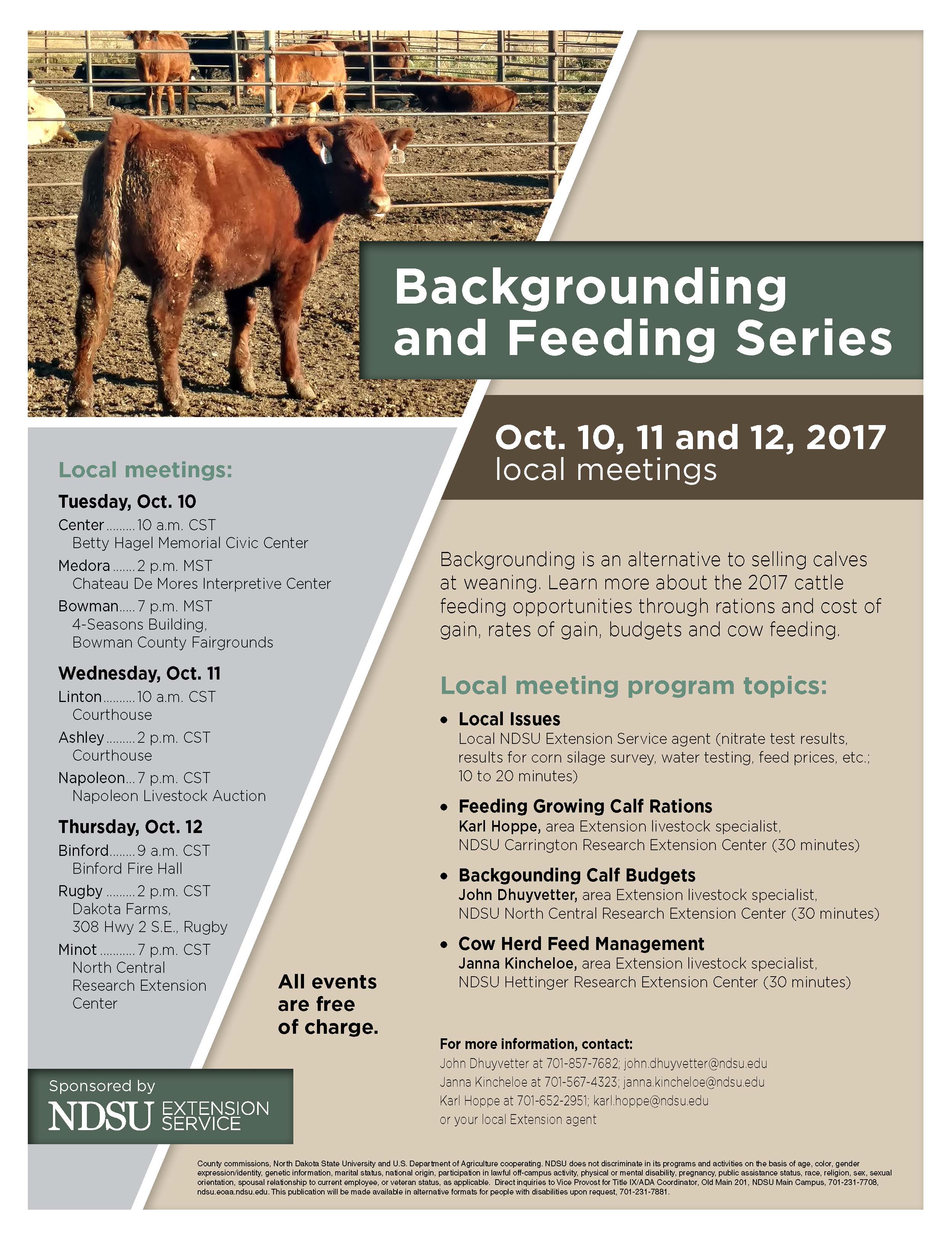
Karl Hoppe, PhD
Karl.Hoppe@ndsu.edu
Area Extension Livestock Specialist / ND SARE Co-Coordinator
Planning for Next Spring
It is the time of year again where we look forward to positive potentials of a new growing season. Harvest is well under way and we have been aggressively cleaning and conditioning our seedstocks since mid-July. Our seedstocks program produced and harvested a series of high quality seed lots as harvest weather was favorable allowing timely harvest. Following is an update you on the status of foundation grade seedstocks available at the Carrington Research Extension Center.
To help you plan for your spring 2018 seedstock plantings, listed in the following table are the foundation grade seedstocks that the CREC has available in our inventories.
*Available as foundation seed to Dakota Select Seed Growers.
Our conventional and GT soybean lines offer a wide range of maturity to work in your location.
The maturity ranges are:
- ND Henson – 00.9
- ND17009GT – 00.9
- Ashtabula – 0.4
- ND Benson – 0.4
- ND Stutsman – 0.7
- ND Benson, a high yielder, offers resistance to Race 3 & 4 of phytophthora root rot and has high resistance to Soybean Cyst Nematode (SCN). As SCN moves into our area, resistant SCN varieties will become more important to reduce yield loss. For disease management, please refer to the SCN Management Guide. This publication is through the North Central Soybean Research Program (NCSRP).
- ND Stutsman is a high yielding soybean. It is resistant to lodging and is tolerant to iron-deficiency chlorosis.
- ND17009GT is a new soybean release from NDSU that is glyphosate tolerant. It is high yielding and has moderate tolerance to iron-deficiency chlorosis.
If you are interested in any of these varieties, you can contact the CREC at 701-652-2951. Other cultivars and additional quantities may be available from other NDSU Research Extension Centers and the NDSU Agronomy Seed Farm. The NDSU Foundation Seedstocks Pricing Committee will set seed prices for this year’s seed soon and the prices will be published in the near future. Within the NDSU Foundation Seedstocks program, seed orders received by December 1 will be given preference and priority when allocating foundation seed.

Dave Copenhaver
David.Copenhaver@ndsu.edu
Foundation Seedstocks Research Spec.
2017 Crop Variety Data Available on Web
Carrington Research Extension Center (CREC) 2017 early season crop variety trial data are available at the website: www.ag.ndsu.edu/varietytrials/carrington-rec/2017-trial-results
Currently, the 2017 crop database includes winter wheat and triticale; spring and durum wheat; barley; oat; field pea; canola; and flax.
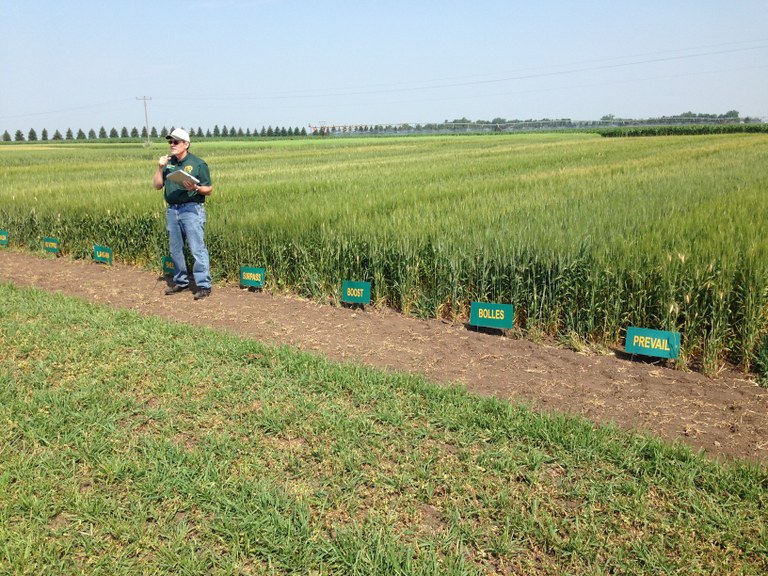
CREC dryland trial
- The top yielding (LSD 0.10) spring wheat varieties (ranging from 62.4 to 66.9 bushels/acre) in the CREC dryland trial: LCS Trigger, Prevail, Prosper, Redstone, Shelly, SY Valda, TCG-Climax, TCG-Spitfire, WB9590, and WB9653.
- Varieties with the highest protein (16.0 to 16.7%) in the CREC dryland trial: Bolles, LCS Breakaway, Linkert, and TCG-Climax.
Dazey off-station trial
- The top-yielding spring wheat varieties (ranging from 96.5 to 100.8 bushels/acre) in the CREC Dazey off-station trial: HRS 3419, Shelly, and WB9719.
- The variety with the highest protein (16.9%) in the Dazey trial: Bolles.
Wishek off-station trial
- The top-yielding spring wheat varieties (ranging from 42.0 to 46.8 bushels/acre) in the CREC Wishek off-station trial: Shelly, SY Ingmar, SY Soren, SY Valda, and WB9719.
- The variety with the highest protein (17.7%) in the Wishek trial: Bolles.
Check the website periodically for data from additional trials.
Greg Endres
Gregory.Endres@ndsu.edu
Area Extension Agronomist
Did You Know?
Did you know we have a “sub-station” near Oakes? The Oakes Irrigation Research Site is located about 4.5 miles south of Oakes, along Highway 1. Established in 1970, the 20-acre site has now doubled in size following the gift of an additional 20 acres from local farmer, Robert Titus, in 2016.
Robert and Elsie Titus partnered with NDSU at the inception of the Oakes Irrigation Research Site, and have continued to lease land to NDSU for research plots for 46 years! In 2016, the couple deeded the original 20 acres and another 20 adjacent acres to the NDSU Development Foundation in a life estate, and the facility has been renamed in their honor as the Robert Titus Research Farm.
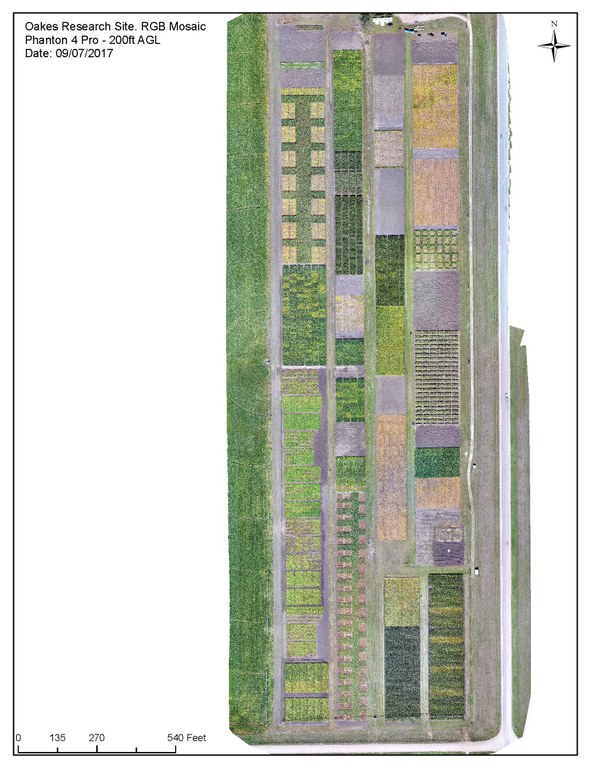
Arial view of Oakes Irrigation Research Site.
After this generous expansion, work began almost immediately on installing a horizontal well to supply water for a new linear irrigation system. The linear irrigation run is controlled through a tablet or smart phone, and features a variable velocity pump that allows regulation of water pressure, even when sections of the line are programmed off.
The doubling of research capacity that began in 2016 allowed us to expand our research efforts on corn and soybean, the two primary crops historically investigated at the site. However, the Oakes Irrigation Research Site also conducts substantial research with potatoes, dry beans and onion, all crops that respond well to supplemental water to reach their full potential. Due to the capabilities of the irrigation infrastructure at the site, a number of research projects are implemented to address crop production challenges that may primarily provide benefit to farmers in other parts of North Dakota. The importance of this research site is recognized by both NDSU researchers and agricultural constituencies since the doubling of acreage at the site is already being fully utilized.
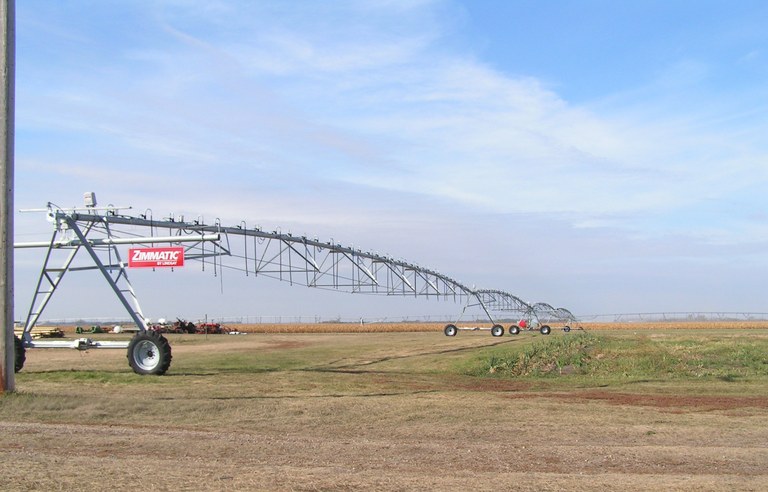
Irrigation System at Oakes Irrigation Research Site.
North Dakota State University faculty and staff from the departments of Plant Sciences, Agricultural and Biosystems Engineering, Plant Pathology, Soil Science and others across the Agricultural Experiment Station participate in conducting experiments at the site. These experiments are conducted with the assistance from the three full-time on-site staff who also conduct their own research projects and maintain the site. Kelly Cooper is our research agronomist, assisted by research specialist, Leonard Besemann and research technician, Heidi Eslinger.
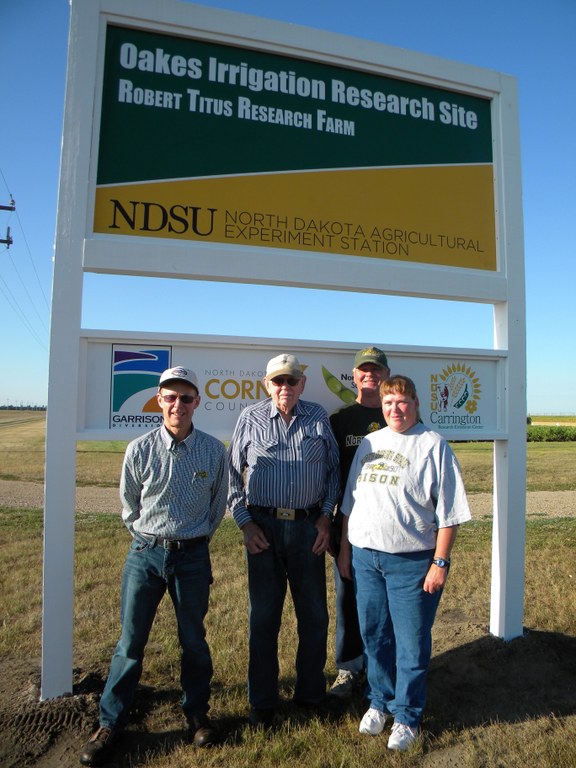
(L-R) Kelly Cooper, Robert Titus, Leonard Besemann, and Heidi Eslinger
The budget to operate the site is completely dependent upon grant funding. The site is a cooperative project between NDSU and the Garrison Diversion Conservancy District, with GDCD providing the majority of the financial support and NDSU scientists providing the balance through their grantsmanship.
The NDSU Oakes Irrigation Research Site Robert Titus Research Farm recently completed their annual Field Day, where participants had the opportunity to view all the field trials along with conversations focused around research developments in white mold (sclerotinia stem rot), dicamba issues, potato breeding, and drone usage.
Blaine Schatz
Blaine.Schatz@ndsu.edu
CREC Director and Research Agronomist
Kelly Cooper
Kelly.C.Cooper@ndsu.edu
Oakes Research Agronomist
Winter Rye Variety Yield Results
Winter rye planting season is near, along with choosing a variety and securing seed to plant. Variety choice is somewhat limited with winter rye although more varieties are becoming available as the acreage has been increasing with this crop over the past few growing seasons. Planting date recommendations for winter rye are not well defined for North Dakota although the planting window is quite wide and it can be planted from early August to November with success. The optimum time recommended for planting is September 10-30. Seeding rates for winter rye are also not well defined for North Dakota. Because of the competitive nature, early season growth characteristics and ability to tiller abundantly seeding rates are also quite variable. Recommended seeding rates are 900,000 to 1,200,000 PLS per acre. It is best to determine seed size or seed per pound for planting rates as the seed size can vary quite extensively with winter rye. An example of this is best illustrated from the nine commercial seed lots used to plant the 2017 state tests that varied from 12,800 to 22,100 seeds per pound.
Trials were planted in the fall of 2016 by NDSU staff to evaluate varieties for grain production at a number of locations across the state. The CREC coordinates the state variety testing program and sent the varieties to Research Centers at Minot, Hettinger, Langdon, and Williston.
Preliminary data has been completed from three sites and is summarized in a table below. Data is averaged from Research Extension Centers at Minot, Langdon and Carrington. New to the trials this year is a hybrid rye named Brasetto from KWS in Germany. This hybrid is extremely high yielding and is being marketed as a high quality winter rye for milling, distilling or malting. Brasetto is shorter with excellent lodging and disease resistance. Seed cannot be saved and a license agreement must be signed. Aroostok and Wheeler are low yielding varieties and are commonly used for cover crop (Aroostok) and forage (Wheeler) applications. The most common varieties available for 2017 fall planting are Hazlet, ND Dylan and Rymin.
Variety trial data is available from individual Research Extension Center Annual reports, Extension Bulletin A1049-16 or the NDSU variety trial website: https://www.ag.ndsu.edu/varietytrials/winter-rye
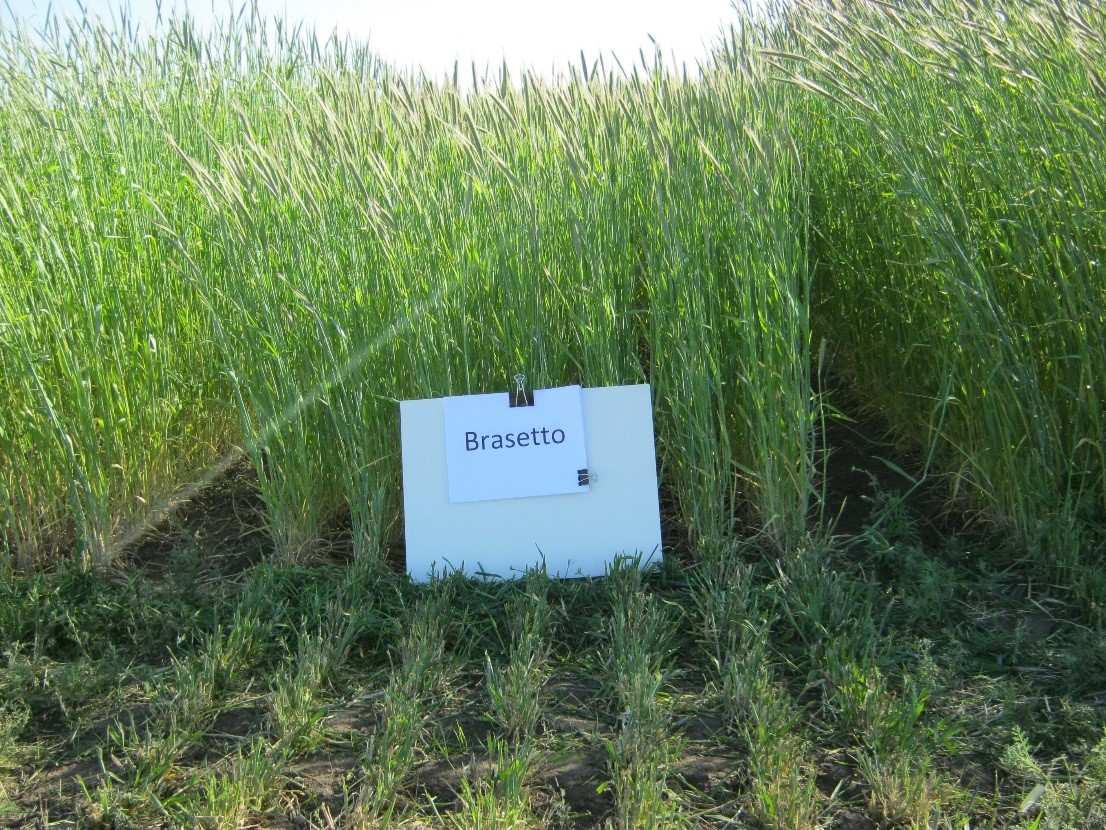
Brasetto hybrid winter rye on June 1 at the CREC.
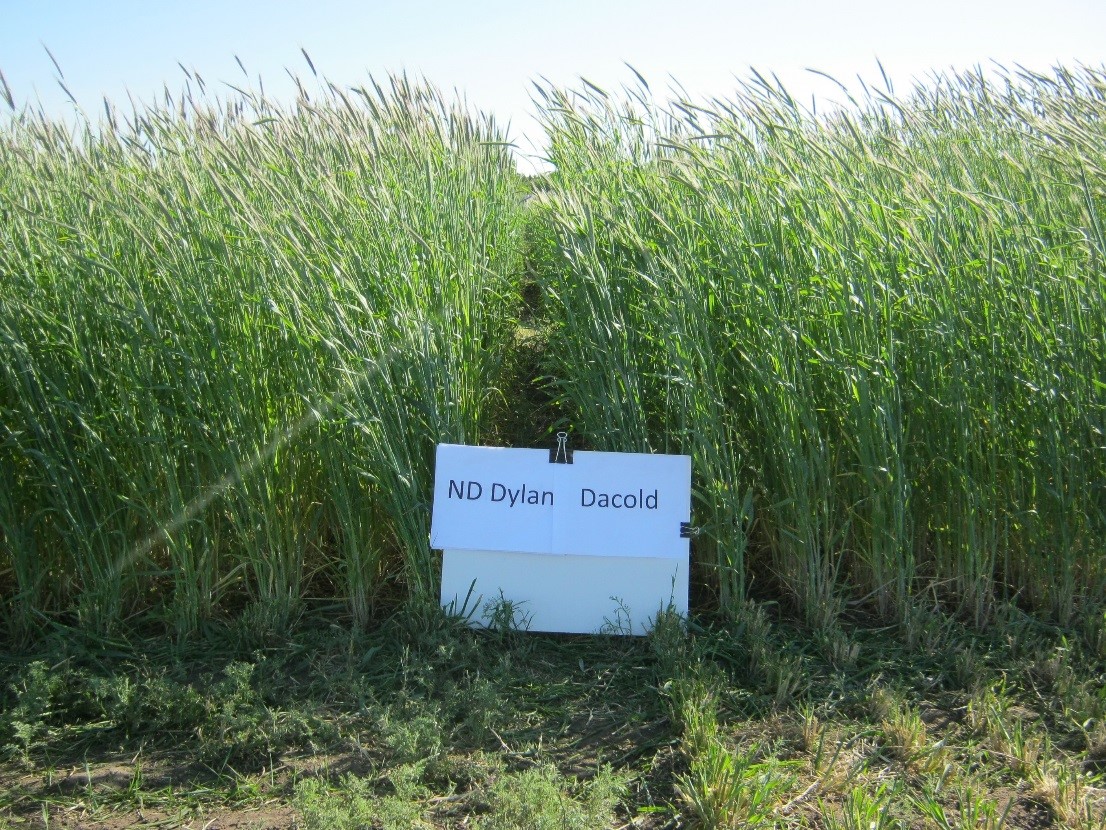
NDSU releases ND Dylan (2016) and Dacold (1989) on June 1 at the CREC.
Steve Zwinger
Steve.Zwinger@ndsu.edu
Agronomy Research Specialist
Brassica carinata
Carinata (brassica carinata) is an oilseed crop that will be entering the marketplace in 2018 for North Dakota. Carinata is a crop that will be used in the biofuel industry and is generating buzz as being the only biofuel that can be used for jet fuel without being blended. This makes it an attractive option for reducing the carbon footprint in the aerospace industry. After processing, the crushed seeds can also be used for cattle feed due to the oil extraction process that will be used, reducing the glucosinolate content.
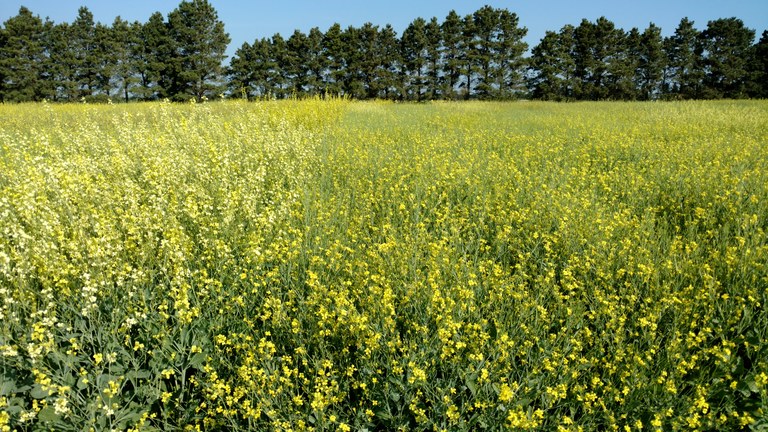
Agronomically, carinata is similar to canola in a lot of ways. At emergence, the two crops are almost identical. The main visual difference is that carinata pods point nearly straight upwards, compared to canola which are mostly horizontal. There are several other differences. Most importantly, carinata is a non-GMO crop, so it will be managed with conventional herbicides. This does reduce the seed cost compared to canola. Carinata has a similar rate of growth to canola, matching some of the later maturing canola varieties. However, carinata does take a fair amount longer to dry down after bloom. Our experience has been that swathing or desiccation occurs roughly 1-2 weeks after most canola. One of the advantages of carinata is that there is less pod shatter as the plants dry down. The hope is that straight combining will be the preferred harvest method. Carinata has yellow, brown, and green seeds and can have yellow or white flowers. Seeding rates are between 5 and 7 lbs/a. Yields are reported to be similar to canola. Unfortunately, our first year of testing was in 2016 when we had significant hail damage, so it is difficult to confirm the yield potential. In 2017, we have a great looking crop, with the plants ready for swathing in the next week or so.
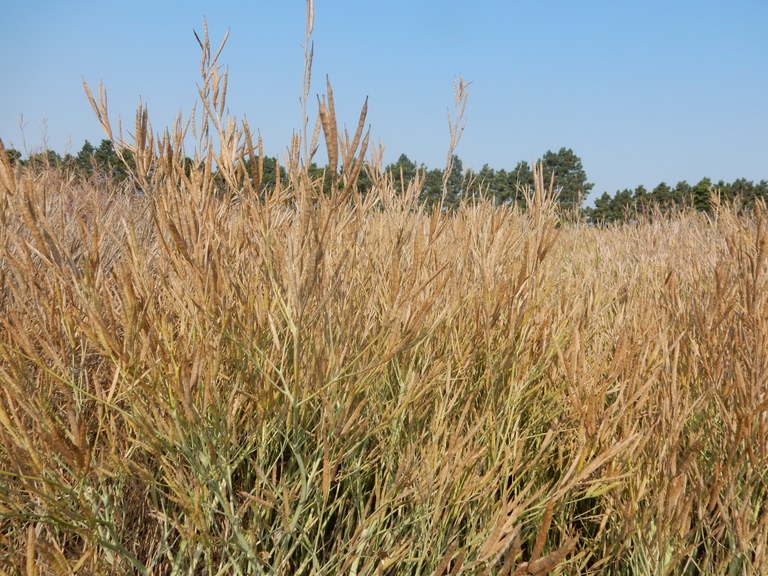
If you are looking for a new crop in your rotation, this could be a good fit. It’s an aggressive and competitive crop and our evidence is indicating that it is a lower input crop than canola. Agrisoma is the group developing the varieties and markets. If you have any questions or interest in the crop, feel free to call or e-mail me.
Mike Ostlie, Ph. D.
mike.ostlie@ndsu.edu
Research Agronomist
How Much Straw Do We Need for the Cow Herd for Bedding?
Last year’s blizzards and cold, snowy winter are a fading memory, but now is the time to stock up adequate bedding in case of another adverse winter.
With this year’s drought, finding hay can be a challenge. Consequently, finding bedding for the cow herd or calf crop isn’t high on the priority list, and even straw may be in short supply due to short stands or the farmer’s desire to leave it on the field. Corn stover is a suitable replacement for straw as bedding.
Straw can be used as backup forage supply. While straw’s feed value is considerably less than good quality hay or silages, when properly supplemented, straw provides some energy value to the ration.
Anderson and coworkers used straw at modest or generous bedding levels as compared to no bedding for feedlot cattle. In that project, steers increased average daily gain by 0.5 pounds per head when bedding was provided. The modest bedding rate was 1-1.5 pound of straw per day during the entire feeding period while generous was 2-3 pounds per head daily. These amounts included days when no additional bedding was needed due to good pen conditions.
A good bedding pack during a snowy winter may require 5-7 pounds of bedding per head daily. Spring thaw may require additional bedding.
At 150 days of a winter feeding period, that’s roughly one round bale of straw or stover per cow for bedding. Having two bales of bedding per cow can provide a buffer for extra bedding or an extra forage supply.
Reference:
Effects of bedding during the winter on performance of growing heifers and finishing steers and impact of straw on nutrients in manure: Vern Anderson, Dale Burr, Tim Schroeder, Larry Swenson and Ezra Aberle.
https://www.ag.ndsu.edu/carringtonrec/documents/annual-reports/2002-annual-report - Pages 13-14
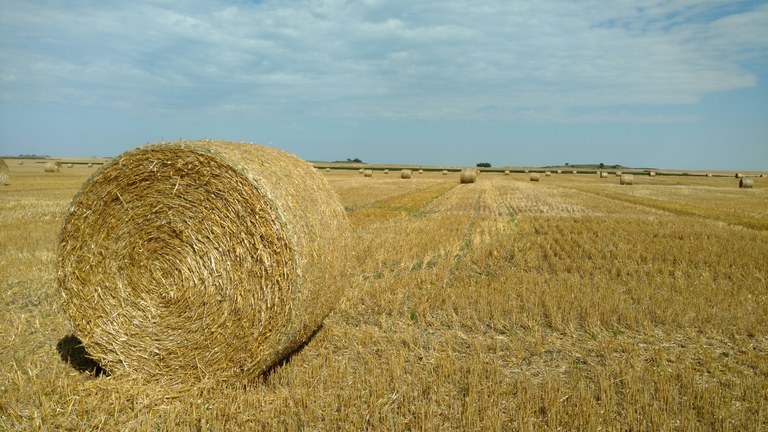
For information about Farmer and Rancher SARE grants go to http://www.northcentralsare.org/Grants/Our-Grant-Programs Application deadline is 12/07/2017.
Karl Hoppe, PhD
Karl.Hoppe@ndsu.edu
Area Extension Livestock Specialist / ND SARE Co-Coordinator
Before you Load up the Hay Wagon: Know What You’re Hauling
This year hay is in short supply and many grain crops have been set back due to drought or hail damage. This may create a market place for a variety of interesting forage options to get cows through the winter. Using alternative forage resources such as grazing or feeding baled crops and residues or using cereal hays may be just the angle you are bending. Before you load up the hay wagon there are some things you should consider.
Evaluating Forage Quality Is Important
Sensory Evaluation
Sensory evaluation includes evaluating the amount of leaf to stem material and uses sight, texture, and smell. The leafy portion of the plant provides the greatest amount of digestible nutrients. A greater leaf to stem ratio can indicate higher quality forage. Bright colored forage indicates proper cure and hay will likely have good palatability for livestock. However, color alone may be deceiving, sun bleaching is not as damaging to forage quality as rain, both of which cause discoloration. Rain can leach soluble nutrients, thus lowering the nutrient content of the forage. Smell can indicate forages that have heated or may have mold problems. Sensory appraisal is important but should not be the stand-alone evaluation method. Sensory evaluations should accompany a nutrient analysis of the forage, by wet chemistry or NIRS (near infrared reflectance spectroscopy).
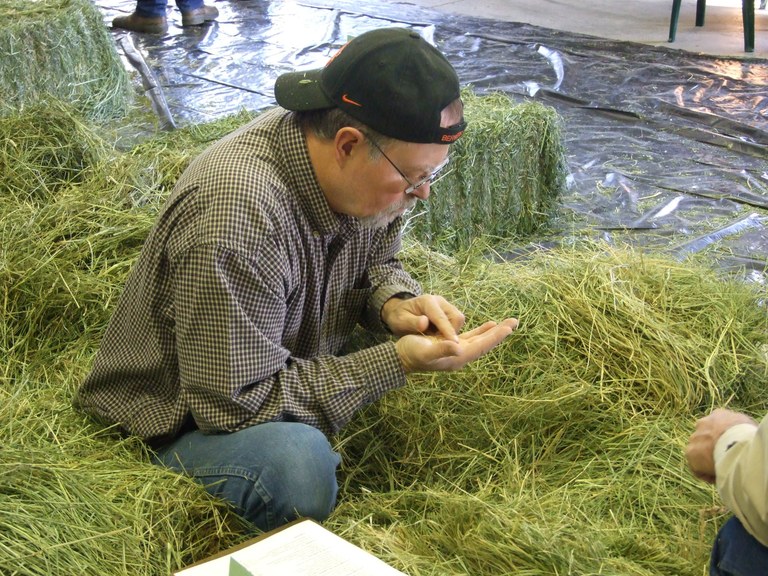
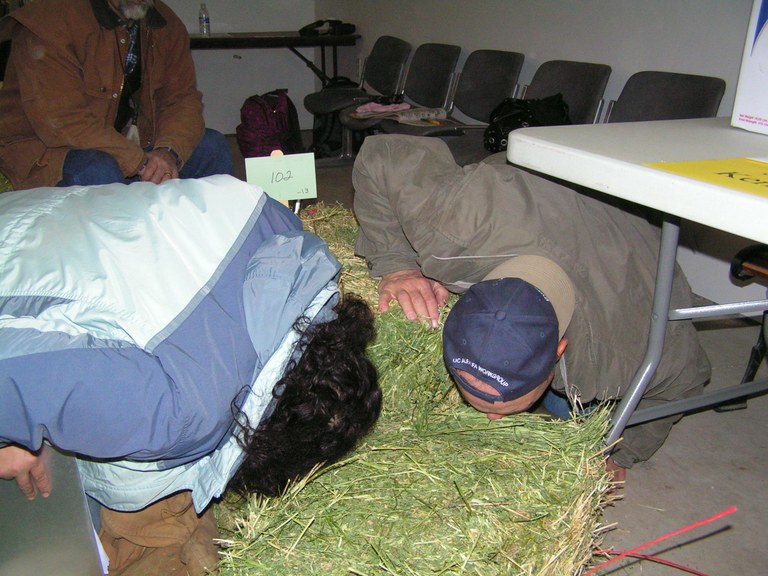
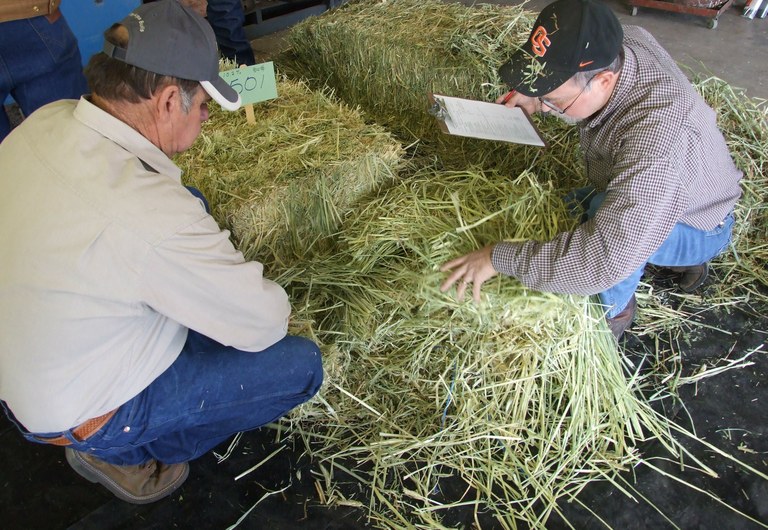
Nutrient Evaluation
Determining the chemical composition is essentially the nutrition label or “feed tag” for the forage. Forage quality testing is important as a management and marketing tool. Selling hay with a hay test allows the seller and buyer to find a price that makes sense. A nutrient analysis helps the end user organize the forage supplies to best match the cow’s nutrient requirements at various stages of production. Another advantage when purchasing hay is not purchasing excess nutrients or paying for nutrients not in the bale.
Forage Sampling Technique
The most important step in analyzing forage quality starts with the technique used in obtaining the “representative” sample to send to the lab. The goal is to obtain a sample that best represents the lot (stack) of forage to be analyzed. A total of 20 cores per lot of hay is the gold standard. Avoid exposing the sample to excessive heat or the sun. Ship the entire sample to a National Forage testing association certified lab as soon as possible.
Bale weight
Another over looked item is bale weight. Hay is frequently sold by the “package” or bale. Not all packages are the same and can range from 1000 to 1500 lbs or more for large round bales. Not all bales have the same dry matter content—it is expensive to purchase and haul water in a bale! Consider purchasing and selling hay on a dry weight basis instead of a package basis.
Sensory and laboratory analysis and known bale weights take the guesswork out of purchasing, selling, and feeding forage and allows for equitable pricing and the ability to meet the nutrient requirements of your livestock.
Chanda Engel
chanda.engel@ndsu.edu
Livestock Research Specialist
North Dakota’s Aronia Crop
Aronia is one of the hottest new crops in the US and in North Dakota. It has been grown in Eastern Europe for a long time because the first crosses of North American Aronia and European Sorbus were made by Ivan Michurin, the great plantsman from Russia, in the early 1900s. The aronia grown today is actually Aronia mitschurinii despite old labeling as A. melanocarpa on many websites. Poland is generally recognized as the producer of 90% of the world’s supply. Interestingly and unfortunately, Poland took over for Ukrainian production due to the 1986 Chernobyl nuclear accident which contaminated the soils of Ukraine.
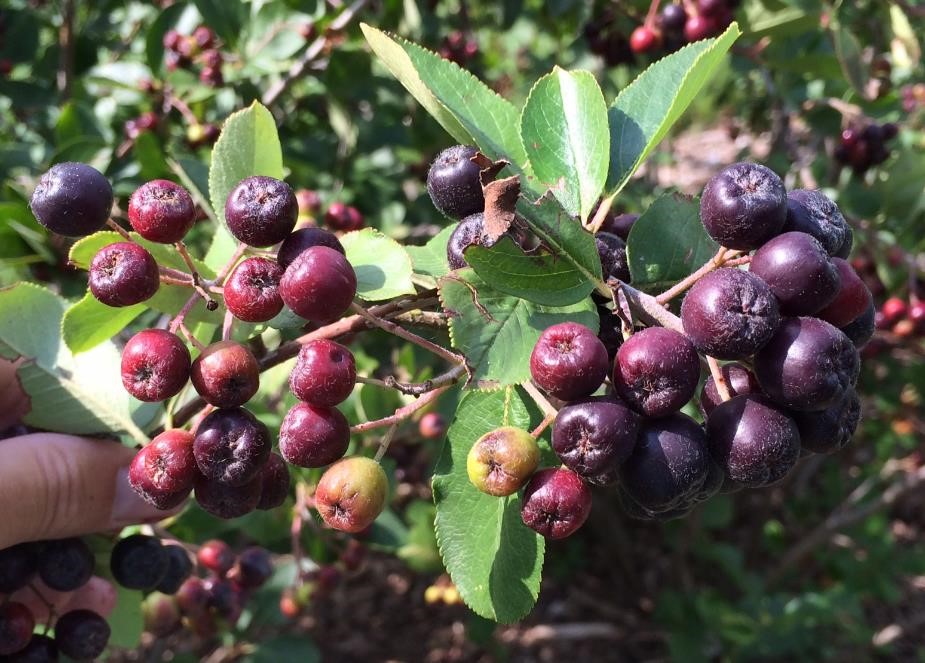 Developing Aronia fruit.
Developing Aronia fruit.
There is great interest in aronia growing in North Dakota! The aronia interest group in the North Dakota Grape and Wine Association counts 62 parties involved with aronia. In 2016, there were 18 growers with almost 90 acres of aronia. (4 growers had registered 70 acres with the Farm Service Agency.) This is approximately an 800% increase in crop acreage in the state in the last five years and 4% of total registered aronia production in the US. Several Pride of Dakota members make and sell jam, jelly and barbeque sauce from aronia berries. There are 15 licensed wineries in North Dakota and many of them produce aronia wine, too. However, additional markets will be needed as the plants mature; the current acreage has the capability of producing 1 million pounds of fruit at 5 years of age.
Each year, the CREC Fruit Project receives inquiries from landowners about growing aronia in North Dakota. Since 2010, the fruit project has had contact with over 10,000 people and many of them learn about aronia here. Let us know if you grow and sell aronia. The CREC can put you in touch with the ND aronia growing group.
- Midwest Aronia Association: http://midwestaronia.org/
- National Aronia Council: https://nationalaroniacouncil.wordpress.com/
- National Aronia Growers in the news: http://blog.hcpd.com/2016/09/akron-ripe-with-aronia-berry-business/
- Research Paper on Aronia classification: http://hortsci.ashspublications.org/content/48/5/520.full
Kathy Wiederholt
Kathy.Wiederholt@ndsu.edu
Fruit Project Manager


